June 10: Pergamum
We leave Assos about 9 a.m. and spend the morning on the bus. The first part of the journey follows a scenic route, off the main highway and along the coast. The small homes near the sea look like nice places to live. Later on, as we turn inland, I noted in my journal that all the buildings are once again 2-4 stories and "blocky". Many buildings are new, quite a few are unoccupied, and many are unfinished, like this one:
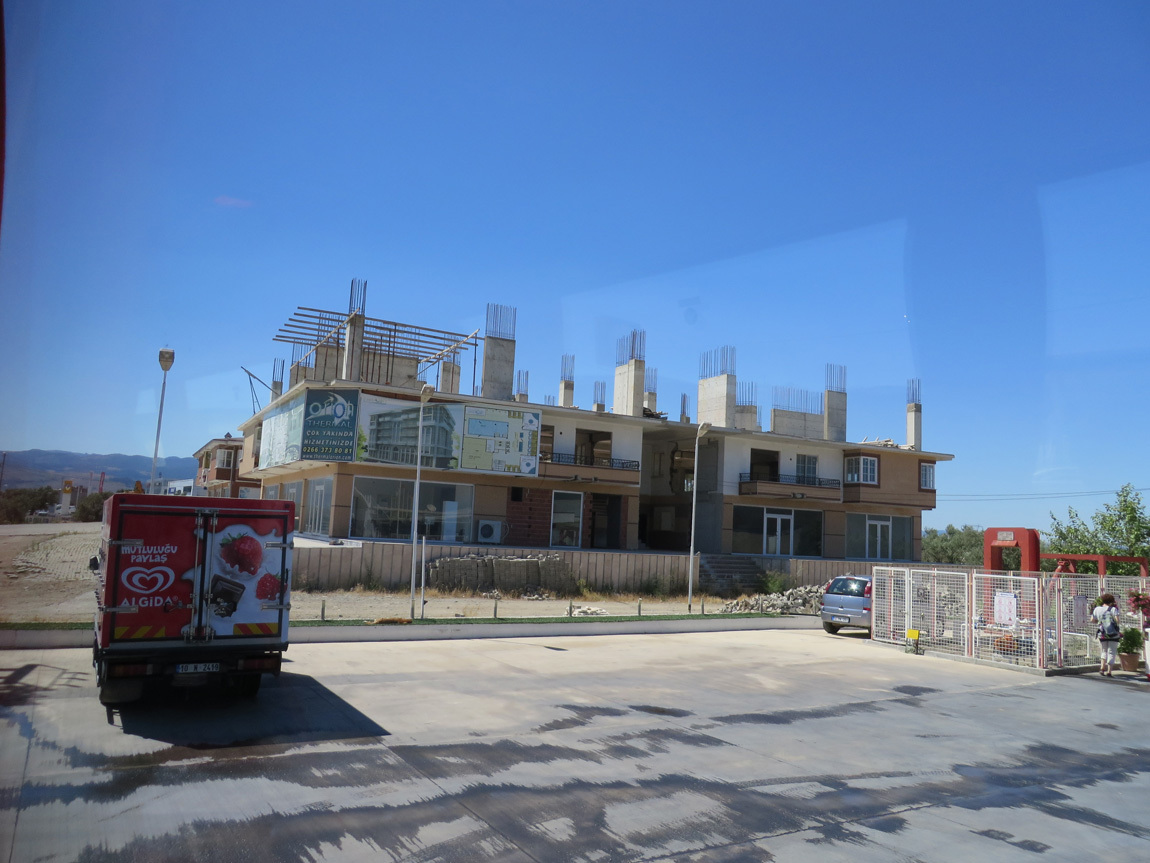
Something seems amiss. Why all this new construction? I understand the Turkish economy is doing well, but maybe it's overextending. Just a comment: This is not my field of expertise.
We lunch at a cafeteria: good fresh salads and hot dishes and mini pizzas and kebabs and honey cakes and baklava. Ali surprises us by playing the baglama (and here) to accompany the guy who runs the cafeteria. Turns out, Ali used to be in a folk band. We enjoyed the performance!
In the afternoon we visit the ruins of the city of Pergamum. The site is at the top of a big hill near the present-day city of Bergama. Luckily there were cable cars to take tourists to the top. Not only was it steep, it was hot! (Again: who would build a city in such a hot place?)
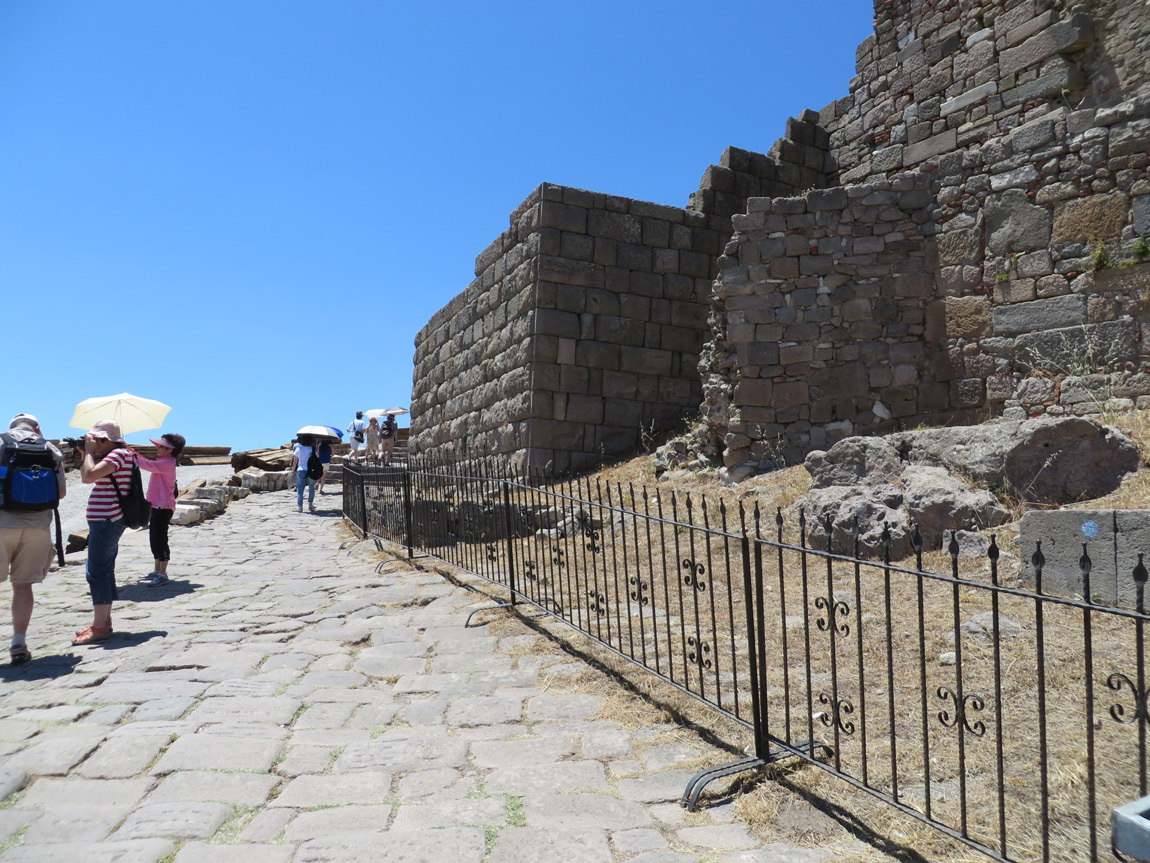
Pergamum was a major city and cultural center during the Hellenistic Greek era. What was the "Hellenistic era"? That's the period from about 323-30 BC, after Alexander the Great conquered the Persian Empire - including the area that is now Turkey. Other centers of Hellenistic culture were Alexandria (Egypt) and Antioch (Turkey). The Greeks brought their culture, their gods, and urbanization to these areas of Asia Minor. They did not always mix with the local populations, but they definitely left their mark.
The Acropolis (hill-top fortified city) of Pergamum included the sanctuaries of Trajan and Athena, palaces, the library of Pergamum, temples, bath complexes, arsenals, shrines, agoras (market places), and the Hellenistic Theater. (Here is a link to a drawing of how the site probably looked during its heyday.) Sadly for us, the Great Altar of Pergamon is in the Pergamon Museum in Berlin, Germany. Only the base of this altar remains at the Acropolis site in Turkey. (Here is the display in the Berlin museum.)
The ancient Library of Pergamum was one of the largest in the ancient Greek civilization. Because of a shortage of papyrus, the Pergamenes invented a new substance to write on, called pergaminus or pergamena, reflecting Pergamum's name. We now call this substance parchment. Pergamum contained 200,000 volumes, which Mark Antony later gave to Cleopatra as a wedding present. (I'm not sure which of my photos is of the library structure.)
Enough is left on the Pergamum site to get a feel for how it once was. Here are parts of the citadel walls:
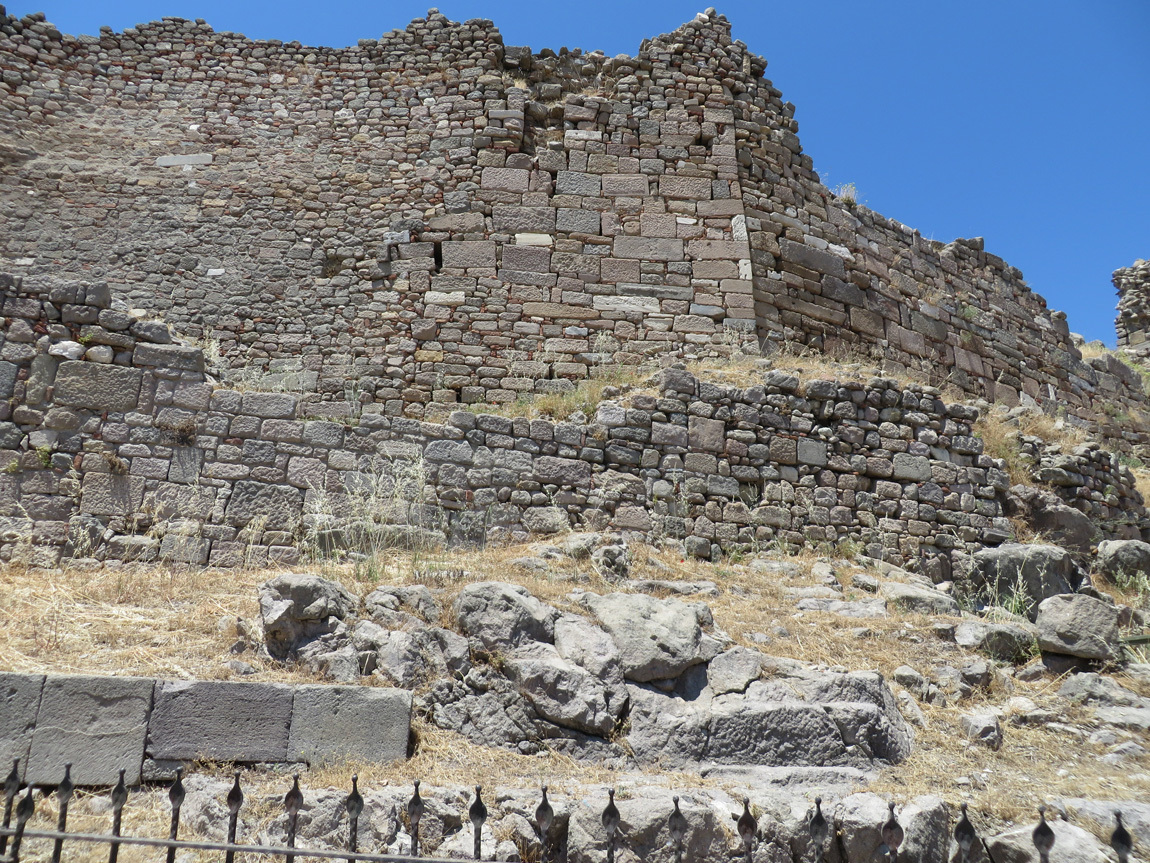
Pergamum was the capital of a small kingdom even before Alexander the Great. This citadel wall was built in the 5th to 4th centuries BC.
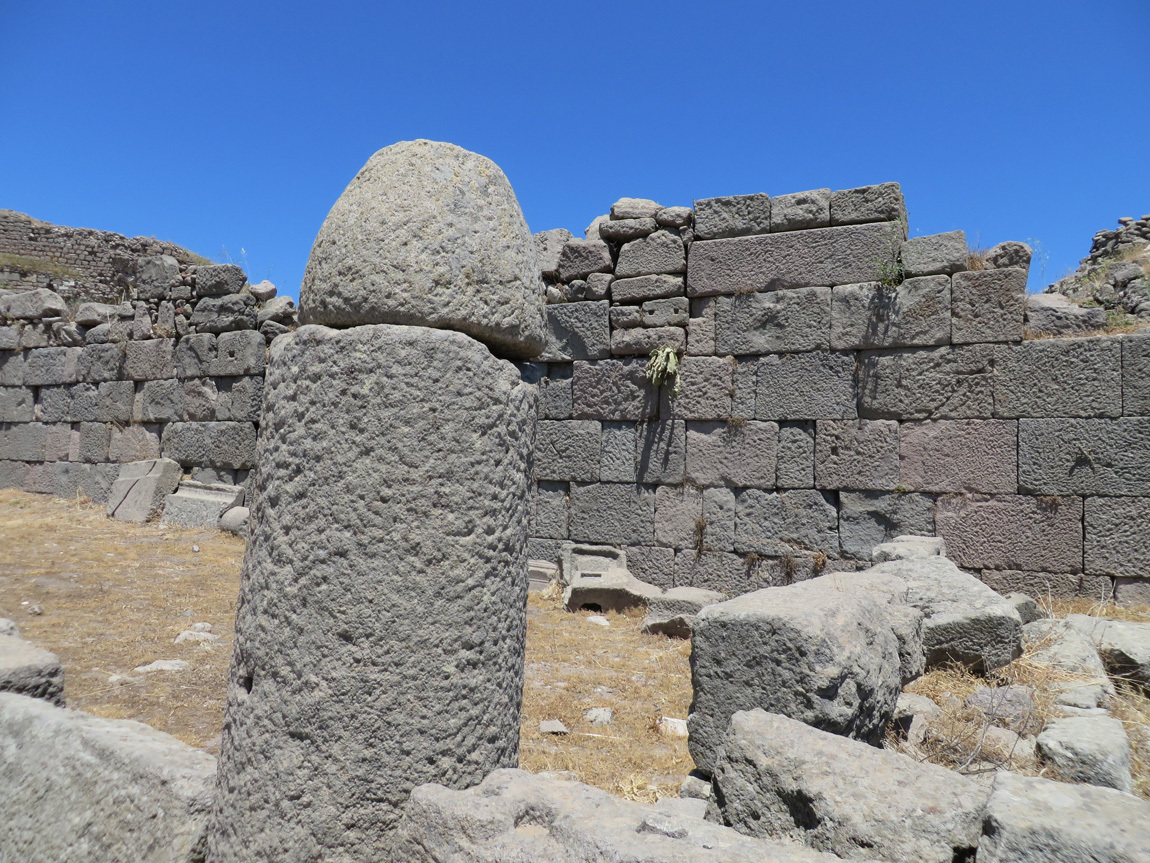
After the Hellenistic era, the city was part of the Byzantine Empire. The city expanded beyond the citadel walls and had over 150,000 inhabitants. As Rome weakened, Pergamum shrank. Walls were re-erected as a defense against Arab attack. By 1453, the Ottoman Turks ruled the city; they constructed more walls and structures and used the city as a castle.
So we are standing on the evidence of over 2000 years of different civilizations building, destroying, and re-purposing structures on this hill.
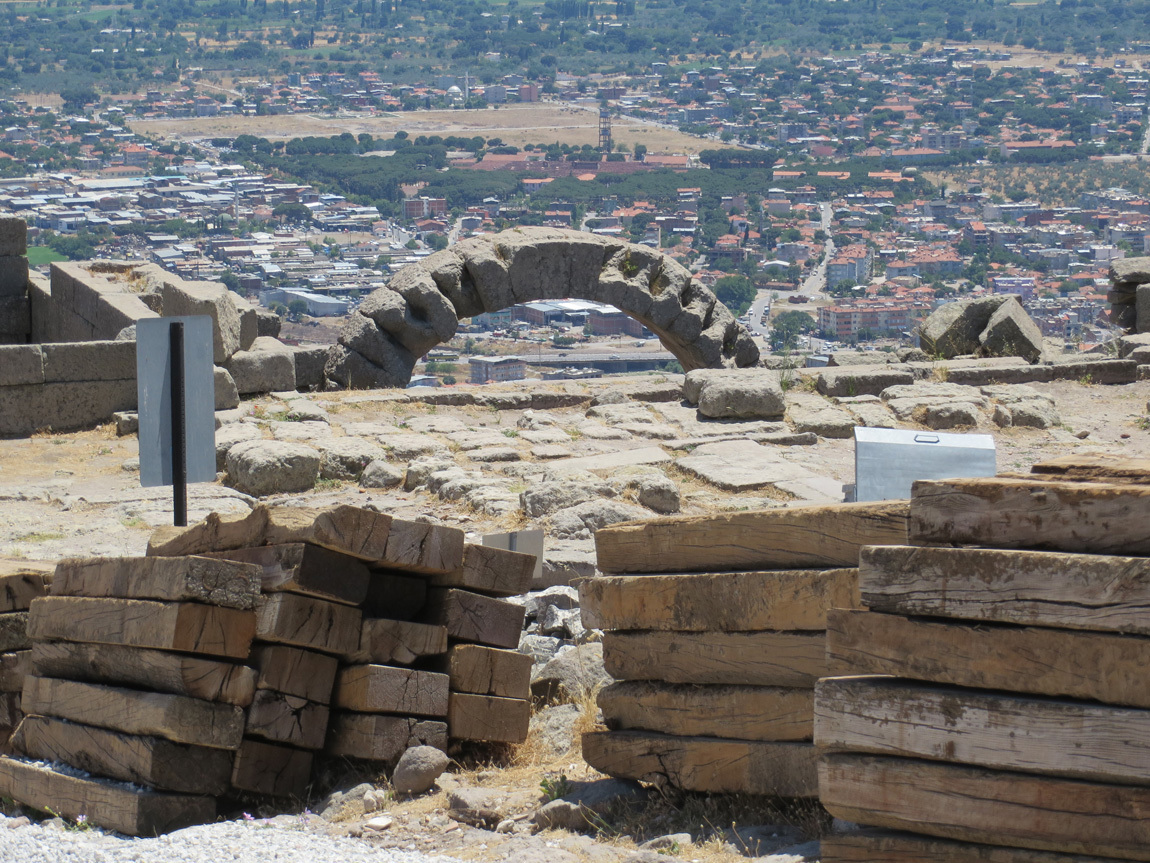
The views from Pergamum are pretty amazing.
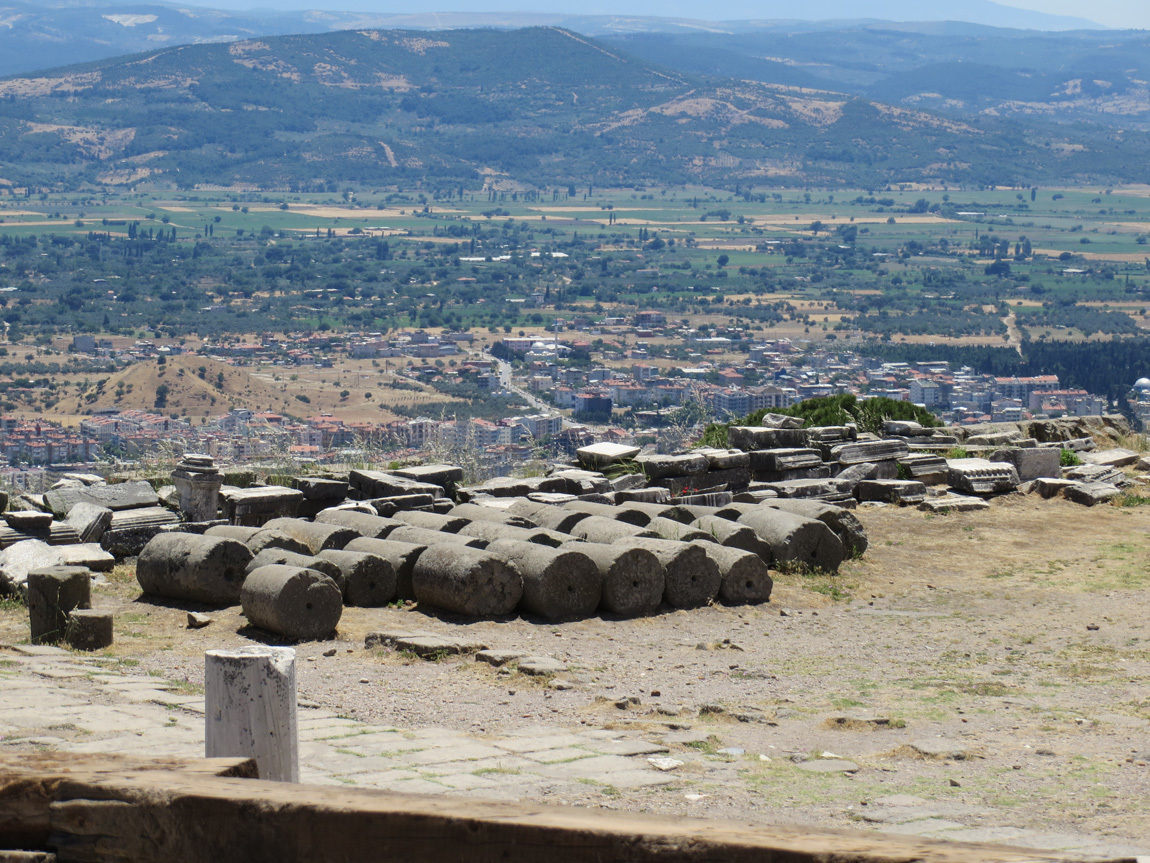
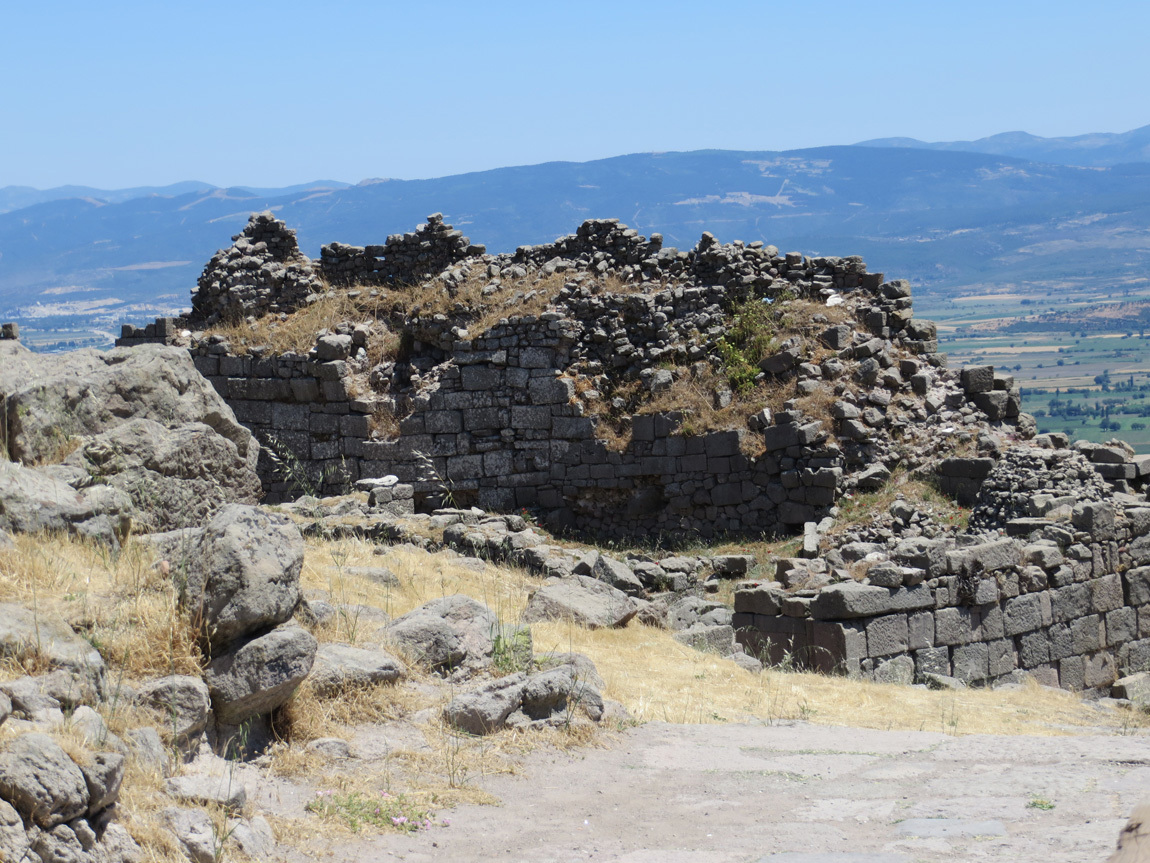
In the Middle Ages the foundation chambers of the temples were re-purposed as cisterns:
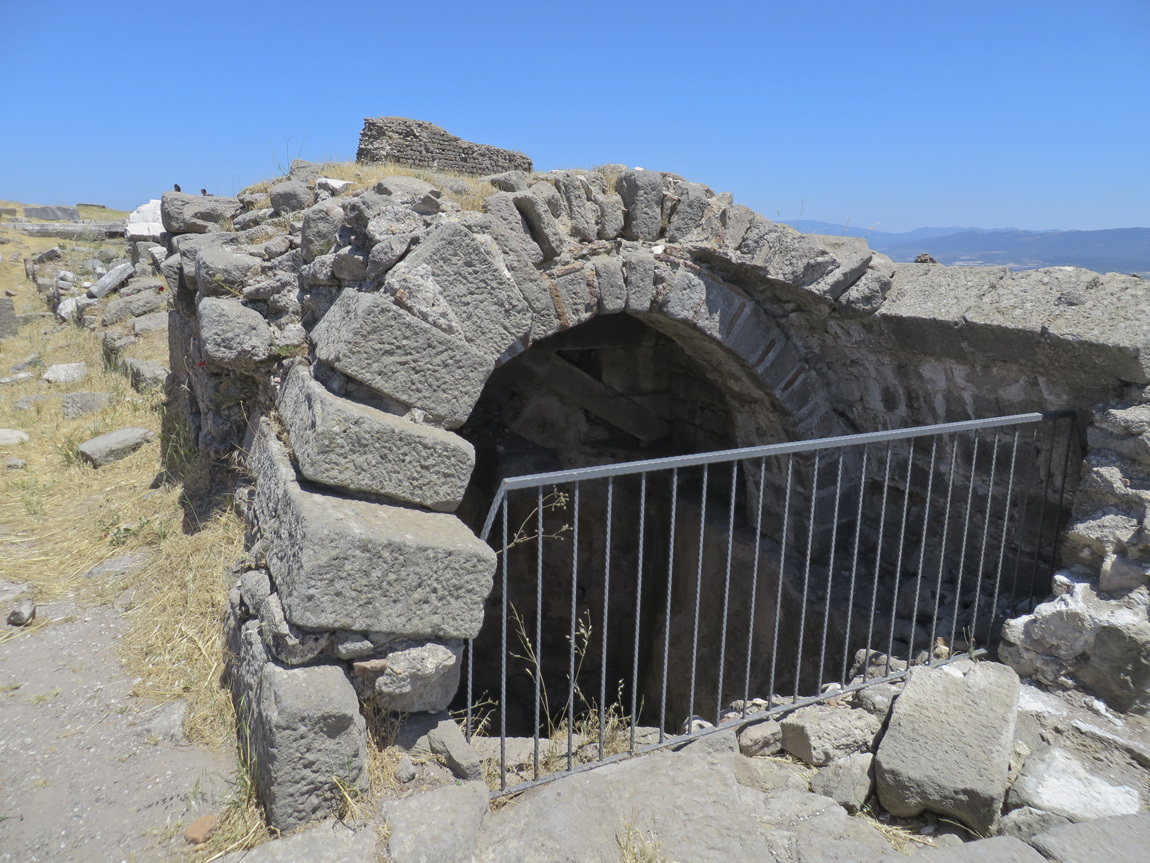
I asked where the water came from since the city is on a hill, and Ali said it was brought to the Acropolis by an aqueduct from a nearby, taller mountain.
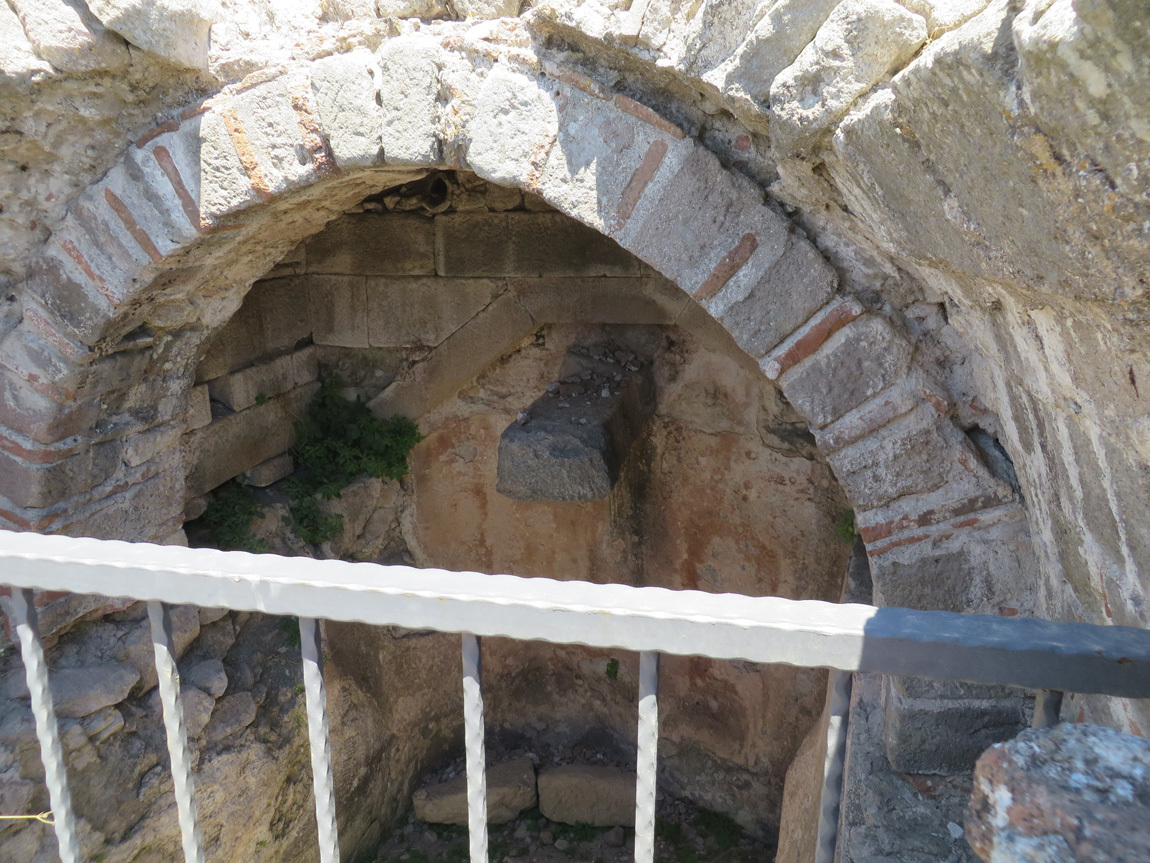
We walked along the paving stones of an ancient road towards the Sanctuary of Trajan, the tall columns you see in the middle of this photo. Look at all of the old, worked stones and pieces of lumber that are laying near the road:
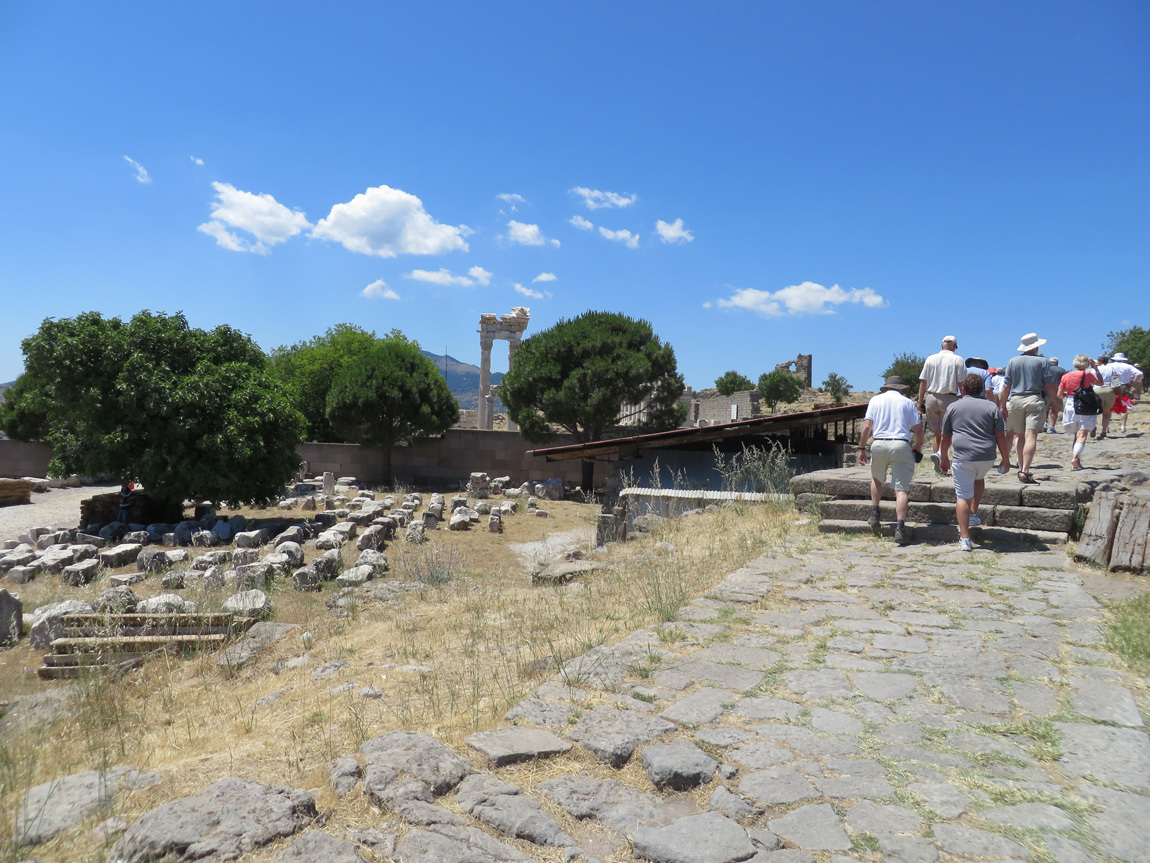
Sanctuary of Trajan ruins:
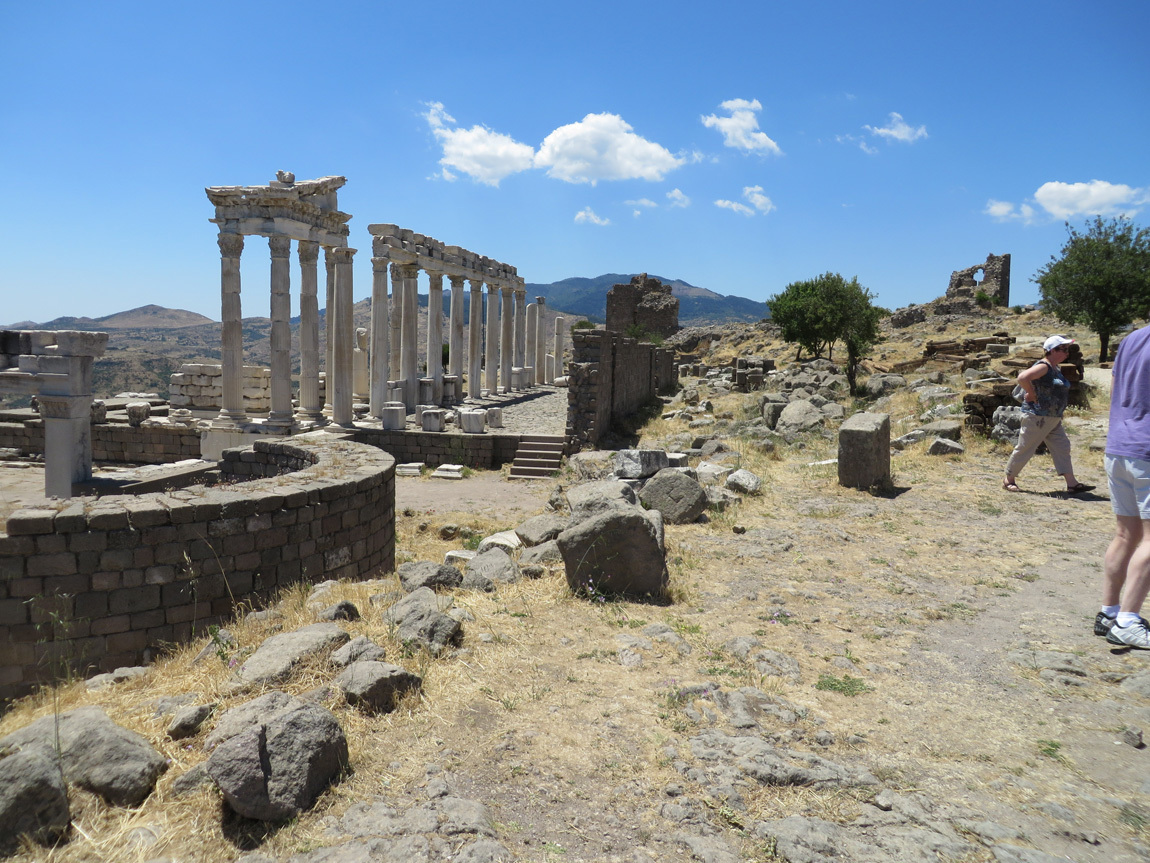
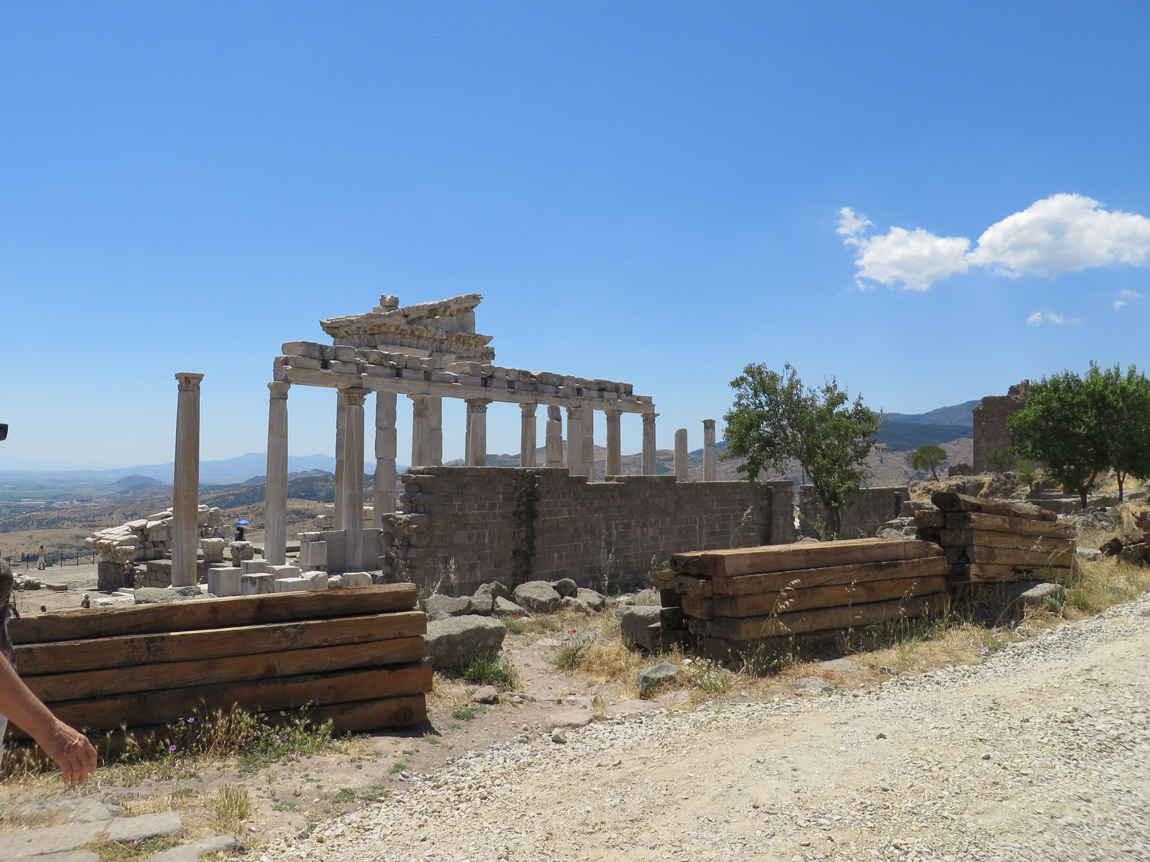
Details of the temple structure:
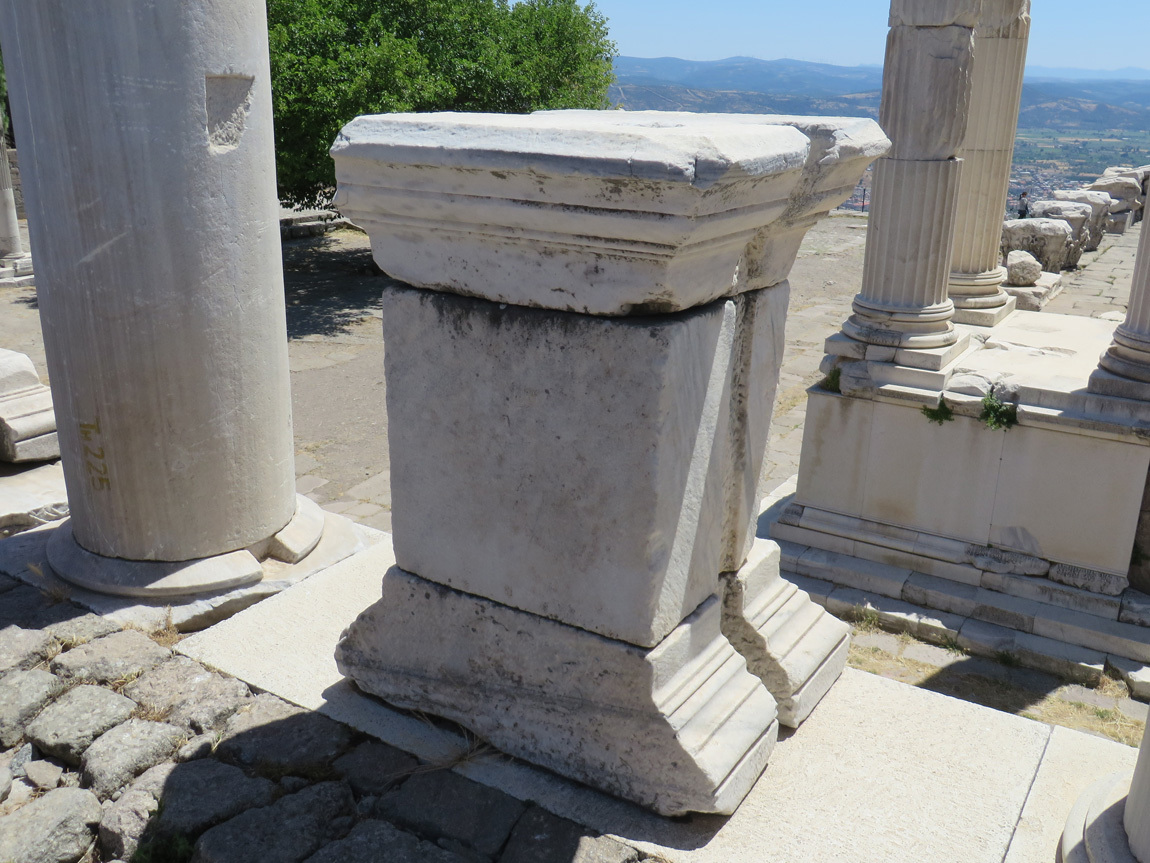
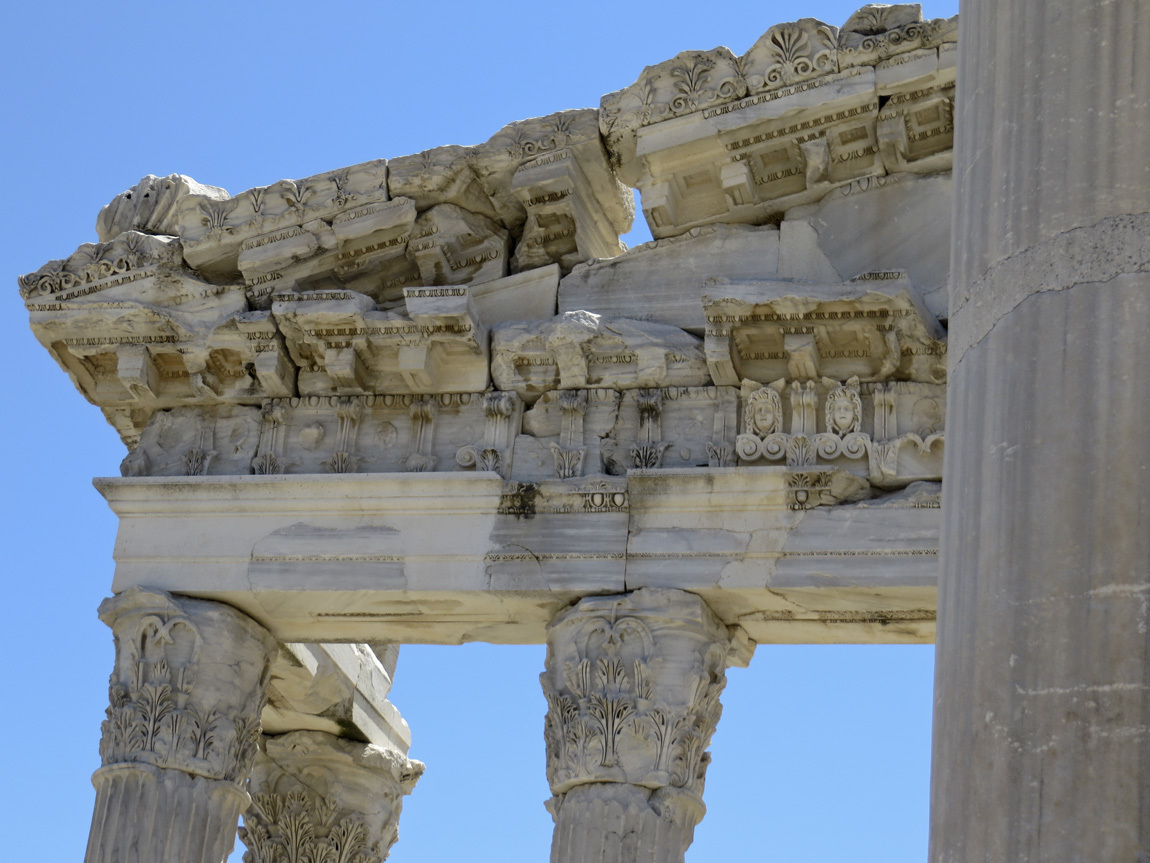
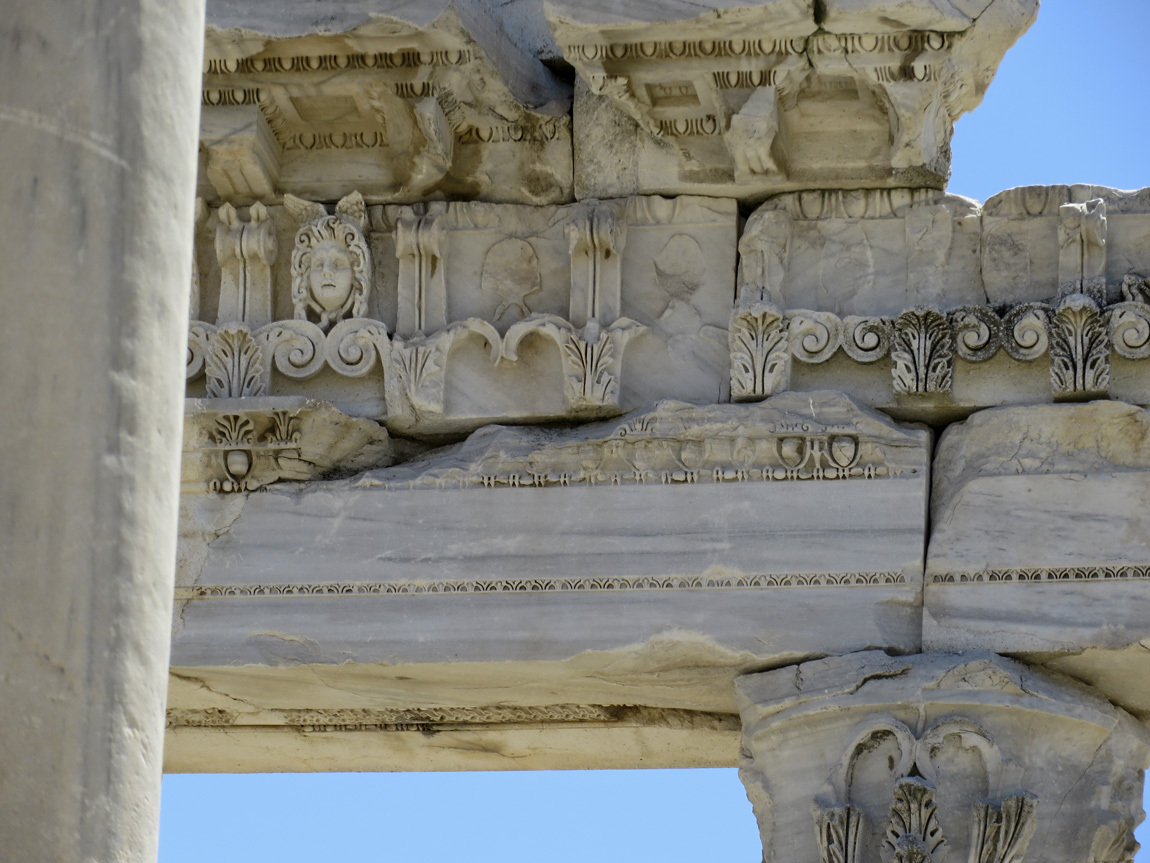
Isn't this all pretty amazing?
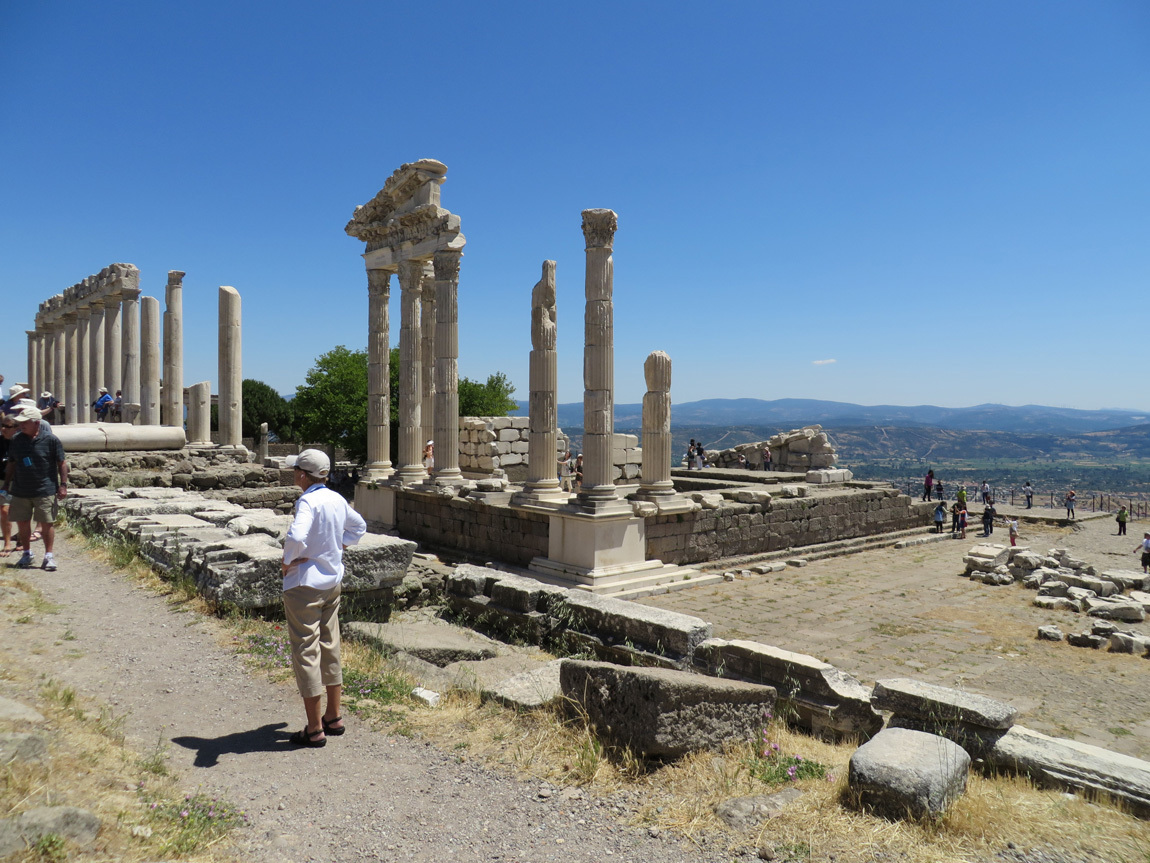
The stacked columns and stone blocks (ashlars) were originally strengthened by metal: first a hole was drilled in two stones, an iron rod inserted, and then lead was poured through the holes and allowed to harden. In the late ancient world, mining declined, increasing the value of metals, and the joining elements of the stone blocks were plundered. Only the foundations are left of this temple:
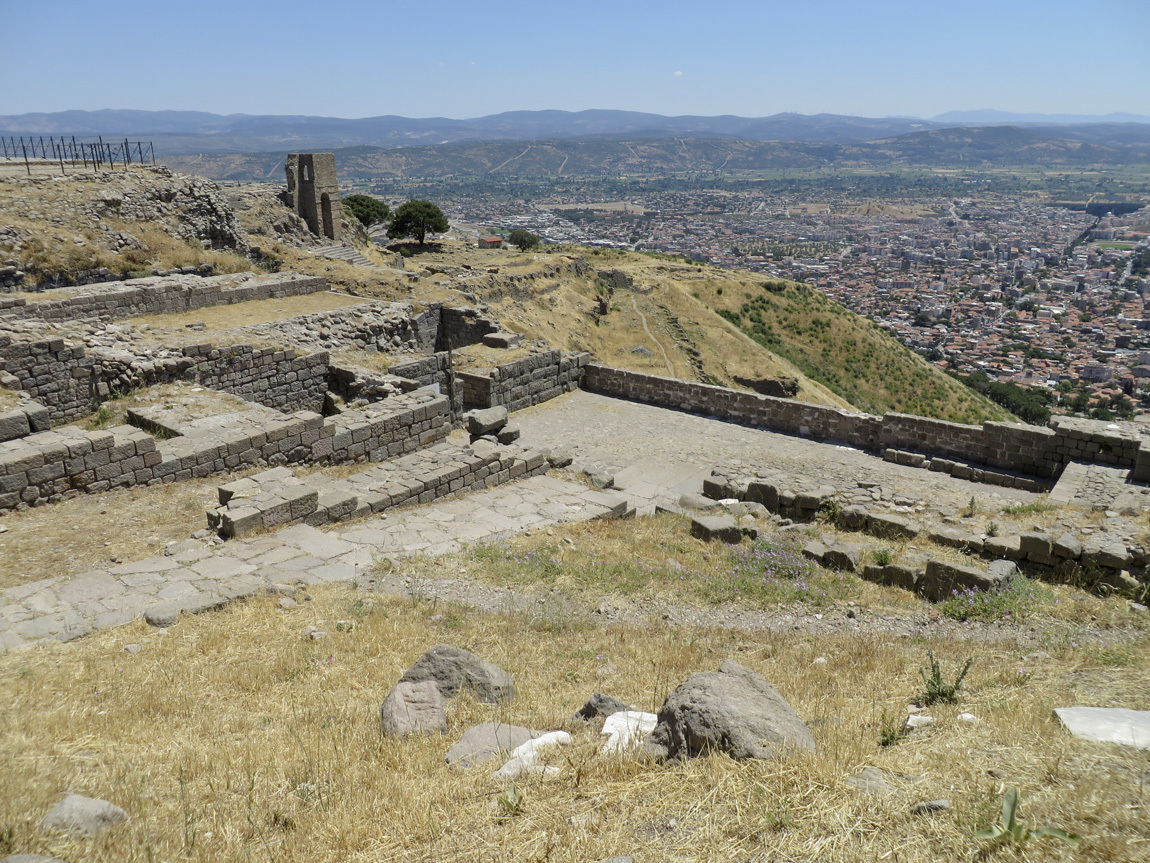
This Hellenistic Theater had a seating capacity of 10,000, and had the steepest seating of any known theater in the ancient world.
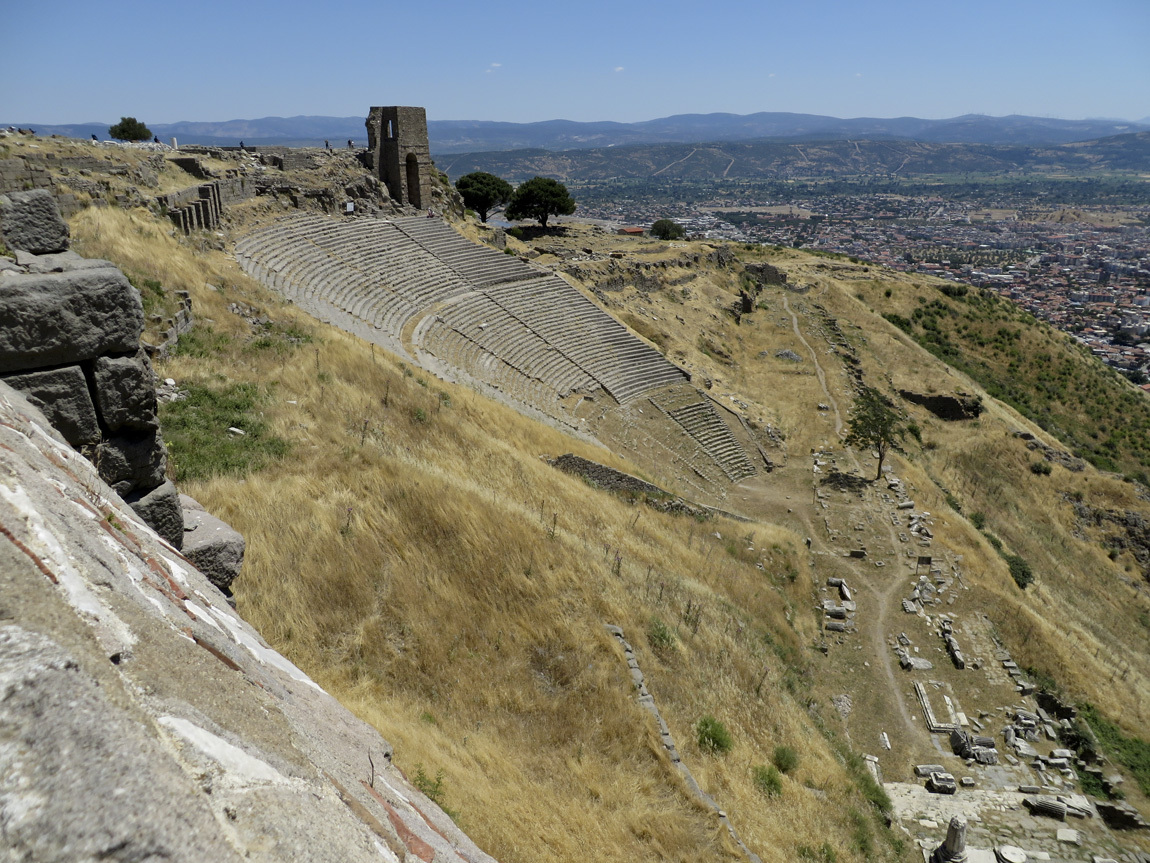
Zoom in:
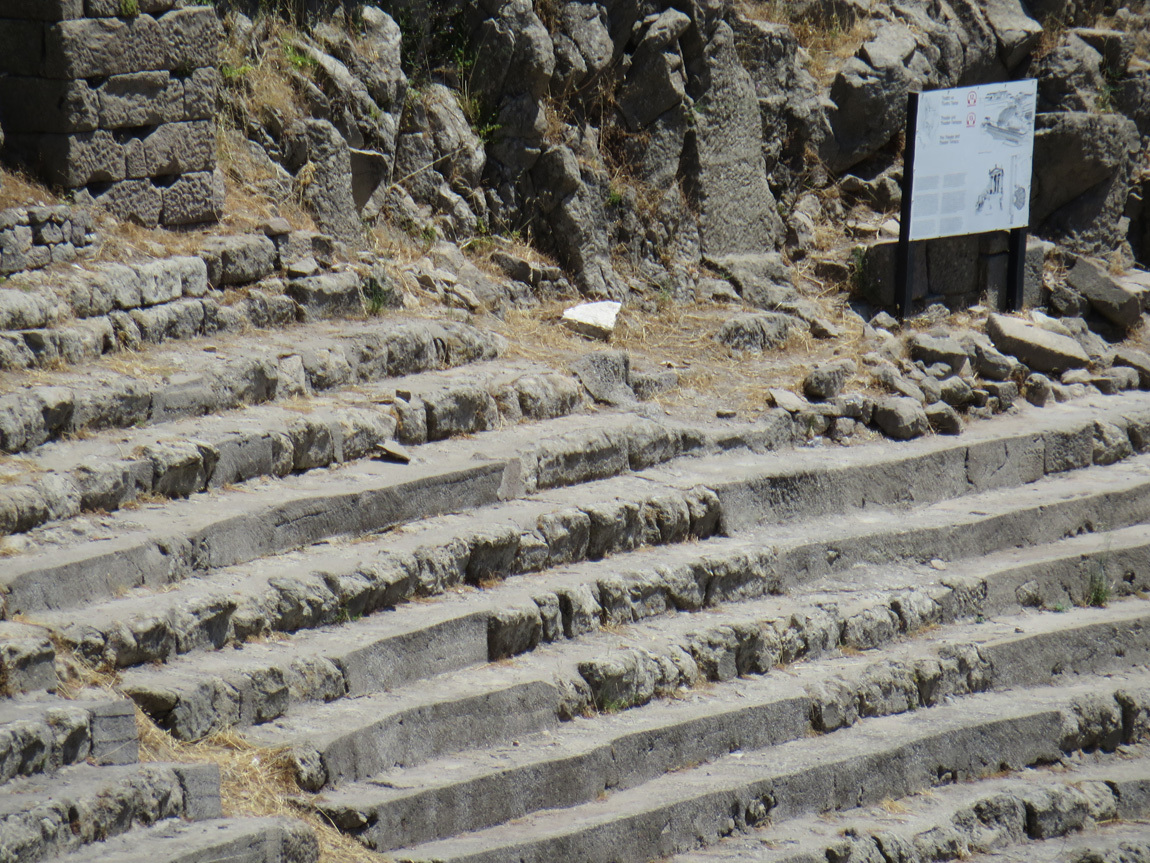
Arches and passageways that formed the foundation for ancient temples.
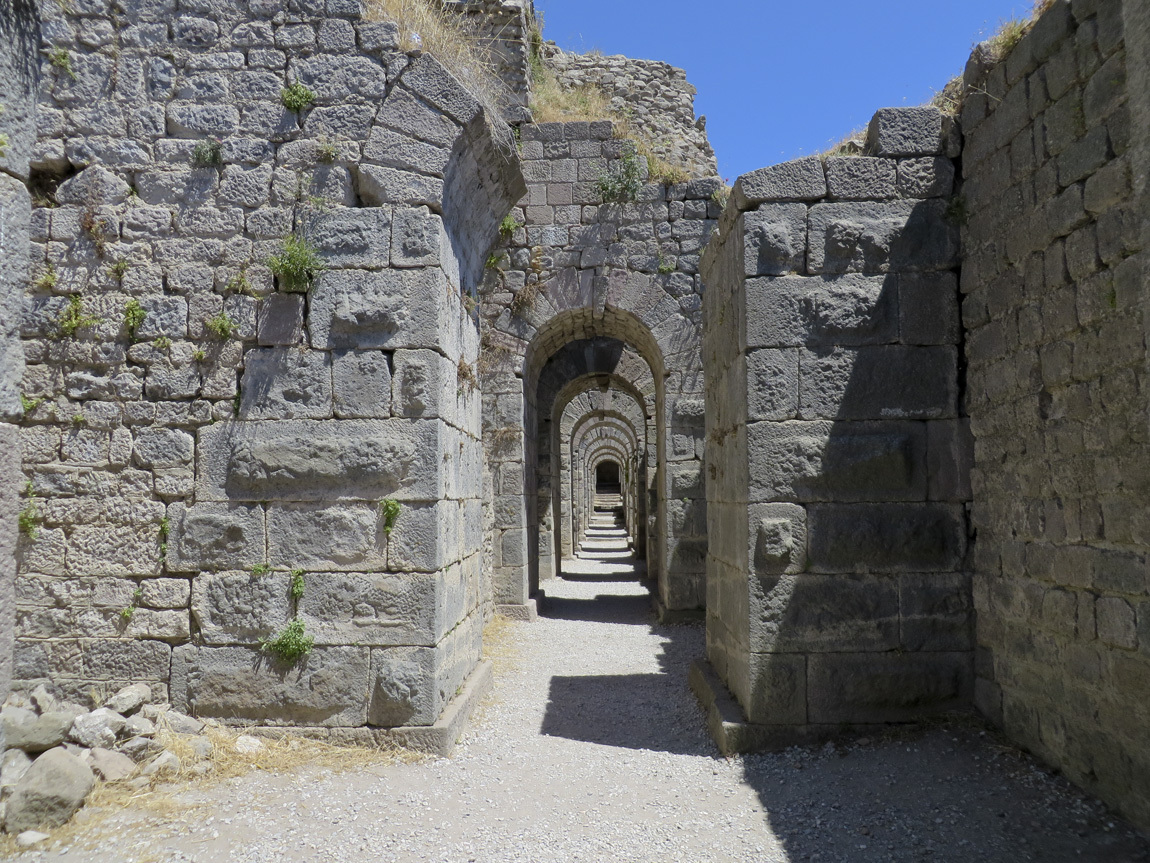
Pieces of old buildings lie in jumbles in alcoves of the foundation.
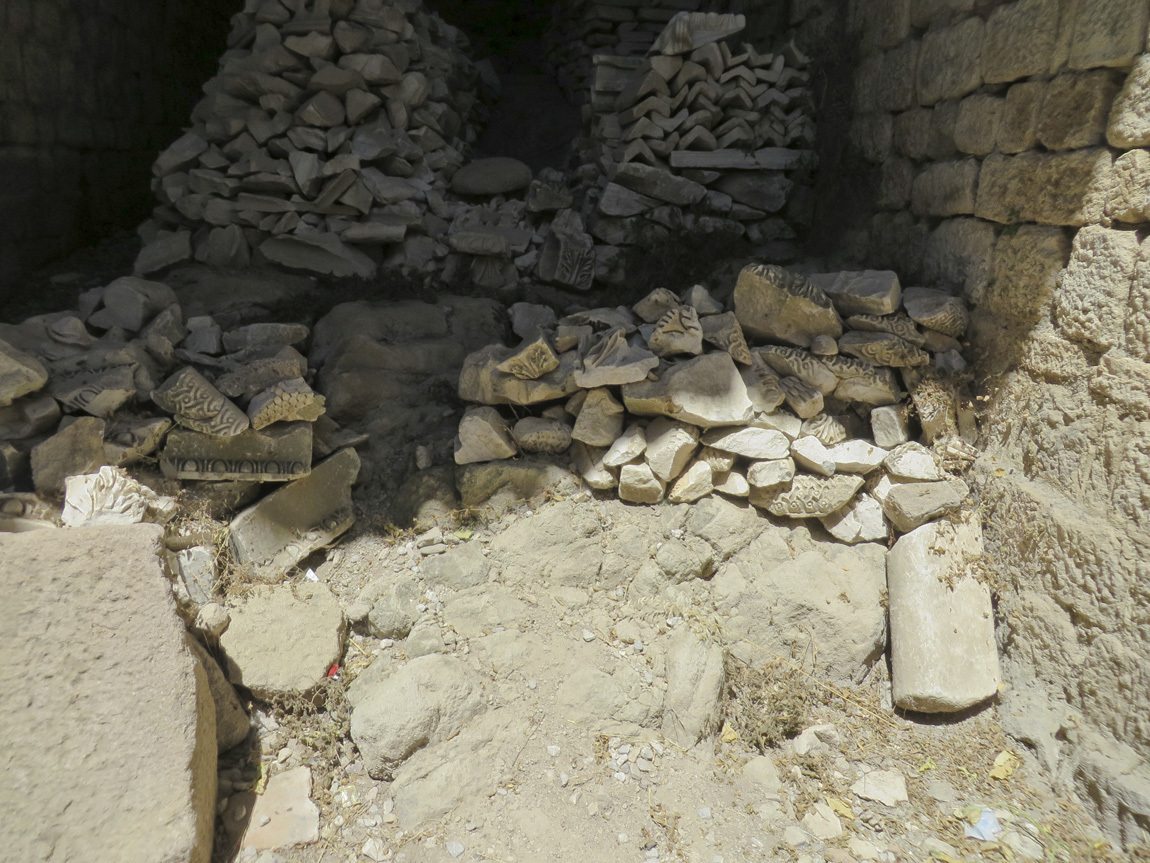
Our group walking up out of the structure.
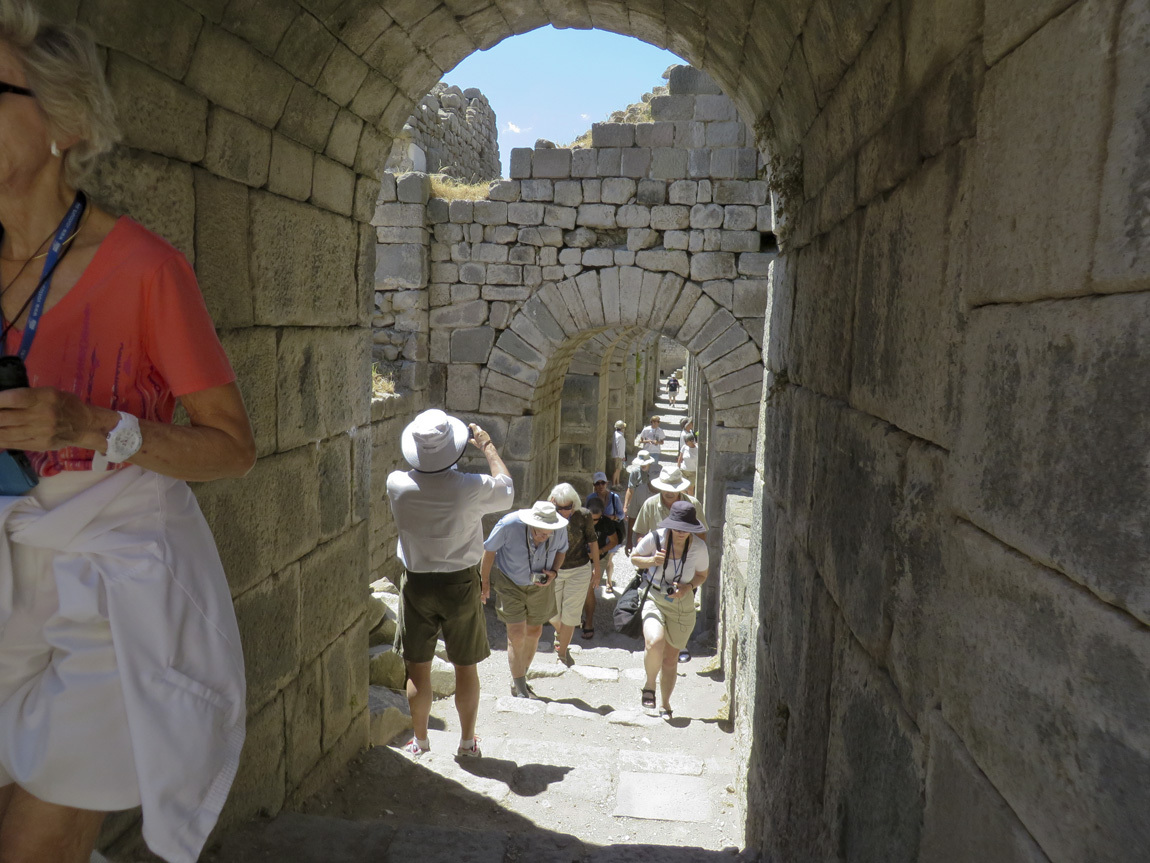
A last look at the view,
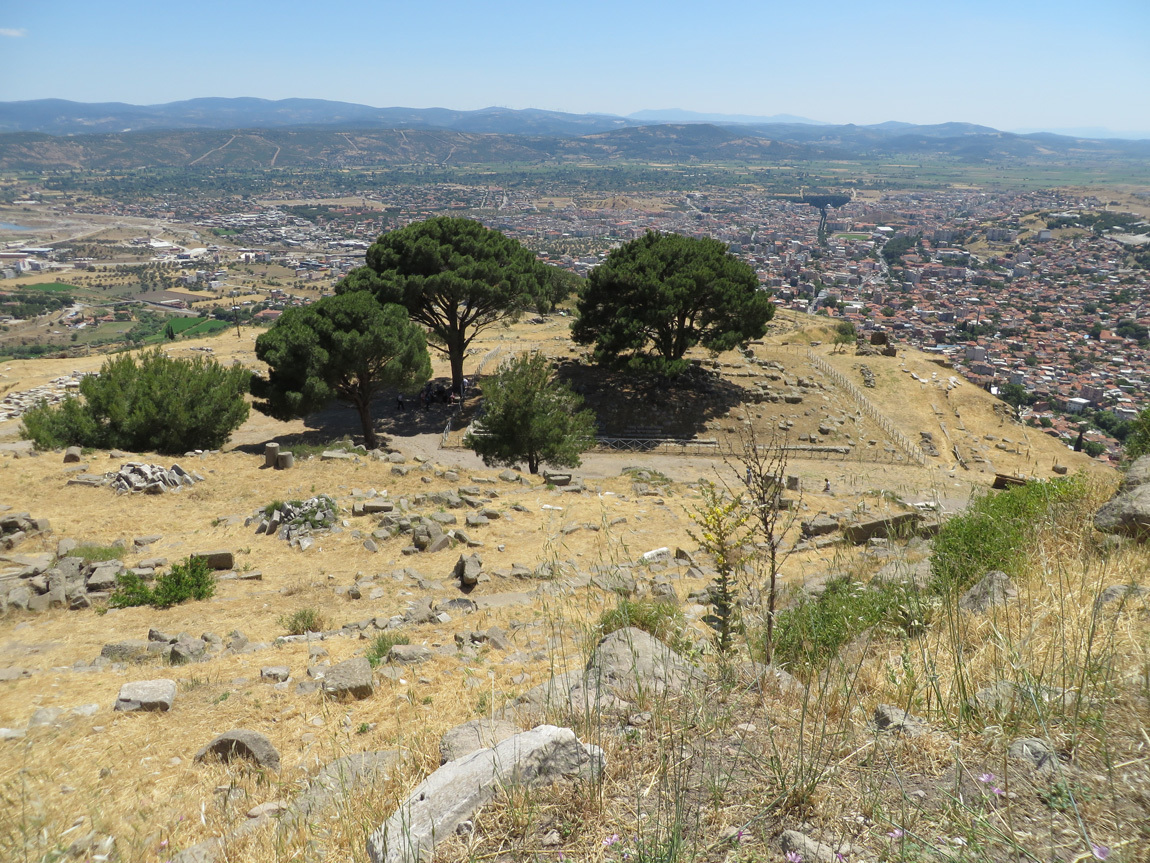
and it's time to head back down the hill to our bus. We've spent only a little more than an hour at this ancient site.
Navigation:
first Turkey post
next Turkey post

Something seems amiss. Why all this new construction? I understand the Turkish economy is doing well, but maybe it's overextending. Just a comment: This is not my field of expertise.
We lunch at a cafeteria: good fresh salads and hot dishes and mini pizzas and kebabs and honey cakes and baklava. Ali surprises us by playing the baglama (and here) to accompany the guy who runs the cafeteria. Turns out, Ali used to be in a folk band. We enjoyed the performance!
In the afternoon we visit the ruins of the city of Pergamum. The site is at the top of a big hill near the present-day city of Bergama. Luckily there were cable cars to take tourists to the top. Not only was it steep, it was hot! (Again: who would build a city in such a hot place?)

Pergamum was a major city and cultural center during the Hellenistic Greek era. What was the "Hellenistic era"? That's the period from about 323-30 BC, after Alexander the Great conquered the Persian Empire - including the area that is now Turkey. Other centers of Hellenistic culture were Alexandria (Egypt) and Antioch (Turkey). The Greeks brought their culture, their gods, and urbanization to these areas of Asia Minor. They did not always mix with the local populations, but they definitely left their mark.
The Acropolis (hill-top fortified city) of Pergamum included the sanctuaries of Trajan and Athena, palaces, the library of Pergamum, temples, bath complexes, arsenals, shrines, agoras (market places), and the Hellenistic Theater. (Here is a link to a drawing of how the site probably looked during its heyday.) Sadly for us, the Great Altar of Pergamon is in the Pergamon Museum in Berlin, Germany. Only the base of this altar remains at the Acropolis site in Turkey. (Here is the display in the Berlin museum.)
The ancient Library of Pergamum was one of the largest in the ancient Greek civilization. Because of a shortage of papyrus, the Pergamenes invented a new substance to write on, called pergaminus or pergamena, reflecting Pergamum's name. We now call this substance parchment. Pergamum contained 200,000 volumes, which Mark Antony later gave to Cleopatra as a wedding present. (I'm not sure which of my photos is of the library structure.)
Enough is left on the Pergamum site to get a feel for how it once was. Here are parts of the citadel walls:

Pergamum was the capital of a small kingdom even before Alexander the Great. This citadel wall was built in the 5th to 4th centuries BC.

After the Hellenistic era, the city was part of the Byzantine Empire. The city expanded beyond the citadel walls and had over 150,000 inhabitants. As Rome weakened, Pergamum shrank. Walls were re-erected as a defense against Arab attack. By 1453, the Ottoman Turks ruled the city; they constructed more walls and structures and used the city as a castle.
So we are standing on the evidence of over 2000 years of different civilizations building, destroying, and re-purposing structures on this hill.

The views from Pergamum are pretty amazing.


In the Middle Ages the foundation chambers of the temples were re-purposed as cisterns:

I asked where the water came from since the city is on a hill, and Ali said it was brought to the Acropolis by an aqueduct from a nearby, taller mountain.

We walked along the paving stones of an ancient road towards the Sanctuary of Trajan, the tall columns you see in the middle of this photo. Look at all of the old, worked stones and pieces of lumber that are laying near the road:

Sanctuary of Trajan ruins:


Details of the temple structure:



Isn't this all pretty amazing?

The stacked columns and stone blocks (ashlars) were originally strengthened by metal: first a hole was drilled in two stones, an iron rod inserted, and then lead was poured through the holes and allowed to harden. In the late ancient world, mining declined, increasing the value of metals, and the joining elements of the stone blocks were plundered. Only the foundations are left of this temple:

This Hellenistic Theater had a seating capacity of 10,000, and had the steepest seating of any known theater in the ancient world.

Zoom in:

Arches and passageways that formed the foundation for ancient temples.

Pieces of old buildings lie in jumbles in alcoves of the foundation.

Our group walking up out of the structure.

A last look at the view,

and it's time to head back down the hill to our bus. We've spent only a little more than an hour at this ancient site.
Navigation:
first Turkey post
next Turkey post
Comments
No comments yet
Add Comment